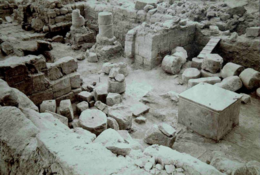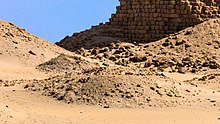
Taharqa, also spelled Taharka or Taharqo, was a pharaoh of the Twenty-fifth Dynasty of Egypt and qore (king) of the Kingdom of Kush from 690 to 664 BC. He was one of the "Black Pharaohs" who ruled over Egypt for nearly a century.

Neferkare Shabaka, or Shabako was the third Kushite pharaoh of the Twenty-fifth Dynasty of Egypt, who reigned from 705 to 690 BC. The Greek sources called him Sabacon (Σαβακῶν) and is mentioned by both Herodotus and Manetho.

Aspelta was a ruler of the kingdom of Kush. More is known about him and his reign than most of the rulers of Kush. He left several stelae carved with accounts of his reign.

Shebitku also known as Shabataka or Shebitqo, and anglicized as Sethos, was the second pharaoh of the Twenty-fifth Dynasty of Egypt who ruled from 714 BC – 705 BC, according to the most recent academic research. He was a son of Piye, the founder of this dynasty. Shebitku's prenomen or throne name, Djedkare, means "Enduring is the Soul of Re." Shebitku's queen was Arty, who was a daughter of king Piye, according to a fragment of statue JE 49157 of the High Priest of Amun Haremakhet, son of Shabaka, found in the temple of the Goddess Mut in Karnak.

Jebel Barkal or Gebel Barkal is a mesa or large rock outcrop located 400 km north of Khartoum, next to Karima in Northern State in Sudan, on the Nile River, in the region that is sometimes called Nubia. The jebel is 104 m tall, has a flat top, and came to have religious significance for both ancient Kush and ancient Egyptian occupiers. In 2003, the mountain, together with the extensive archaeological site at its base, were named as the center of a World Heritage Site by UNESCO. The Jebel Barkal area houses the Jebel Barkal Museum.
Napata was a city of ancient Kush at the fourth cataract of the Nile founded by the Egyptian Amun cult for Egyptian pilgrims given by its, as suggested, Egyptian name. It is located approximately 1.5 kilometers from the east side of the river at the site of modern Karima, Sudan.
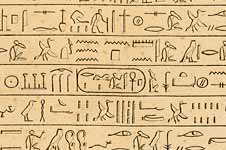
Alara was a King of Kush, who is generally regarded as the founder of the Napatan royal dynasty by his 25th Dynasty Kushite successors and was the first recorded prince of Kush. He unified all of Upper Nubia from Meroë to the Third Cataract and is possibly attested at the Temple of Amun at Kawa. Alara also established Napata as the religious capital of Kush. Alara himself was not a 25th dynasty Kushite king since he never controlled any region of Egypt during his reign compared to his two immediate successors: Kashta and Piye respectively. Nubian literature credits him with a substantial reign since future Nubian kings requested that they might enjoy a reign as long as Alara's. His memory was also central to the origin myth of the Kushite kingdom, which was embellished with new elements over time. Alara was a deeply revered figure in Nubian culture and the first Kushite king whose name came down to scholars.

Nastasen was a king of Kush who ruled the Kingdom of Kush from 335 to 315/310 BCE. According to a stela from Dongola, his mother was named Queen Pelkha and his father may have been King Harsiotef. His successor was Aryamani.

Senkamanisken was a Kushite King who ruled from 640 to 620 BC at Napata. He used royal titles based on those of the ancient Egyptian pharaohs.

Anlamani was a king of the Kingdom of Kush in Nubia, who ruled from 620 BC and died around 600 BC.

Nuri is a place in modern Sudan on the west side of the Nile, near the Fourth Cataract. Nuri is situated about 15 km north of Sanam, and 10 km from Jebel Barkal.

The Kingdom of Kush, also known as the Kushite Empire, or simply Kush, was an ancient kingdom in Nubia, centered along the Nile Valley in what is now northern Sudan and southern Egypt.
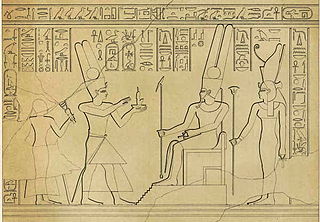
Abar was a Nubian queen of the Kingdom of Kush dated to the Twenty-fifth Dynasty of Egypt. She is known from a series of stela found in Sudan and Egypt. Her appearances mark her as the niece of King Alara of Nubia, married to King Piye and the mother of King Taharqa.
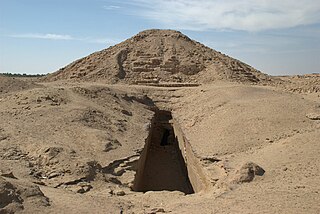
El-Kurru was the first of the three royal cemeteries used by the Kushite royals of Napata, also referred to as Egypt's 25th Dynasty, and is home to some of the royal Nubian Pyramids. It is located between the 3rd and 4th cataracts of the Nile about 1 mile (1.6 km) west of the river in what is now Northern state, Sudan. El-Kurru was first excavated by George Reisner in 1918 and 1919 and after his death his assistant Dows Dunham took over his work and published the excavation report on El-Kurru in 1950. The El Kurru cemetery was primarily used from about 860 BC until 650 BC. The first tomb with a name attached to it is that of King Piye dating to about 750 BC, the sixteen earlier tombs possibly belong to Piye's royal predecessors. The last 25th dynasty king, Tantamani, was buried at El Kurru around 650 BC. The subsequent Napatan rulers chose to be buried at the royal cemetery at Nuri instead. However, in the mid-4th century the 20th king, whose name is unknown, chose to have his tomb, as well as that of his queen, built at El Kurru.

Siaspiqa was a ruler of the Kushite kingdom of Meroë reigning for close to twenty years in the first half of the 5th century BC. Very little is known of Siaspiqa's activities beyond the construction of his pyramid at Nuri, now known as Nuri 4. The pyramid and its chapel have yielded several inscribed stelas bearing his name as well as numerous artefacts suggesting a once rich burial. Nothing is known for certain on the relations between Siaspiqa and his predecessor Amaniastabarqa and successor Nasakhma. Equally uncertain is the identity of his consort, with queen Pi'ankhqewqa buried in the nearby Nuri 29 conjectured for that role.

The Twenty-fifth Dynasty of Egypt, also known as the Nubian Dynasty, the Kushite Empire, the Black Pharaohs, or the Napatans, after their capital Napata, was the last dynasty of the Third Intermediate Period of Egypt that occurred after the Kushite invasion.
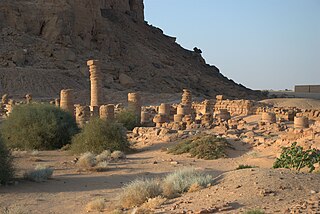
The Temple of Amun is an archaeological site at Jebel Barkal in Northern State, Sudan. It is situated about 400 kilometres (250 mi) north of Khartoum near Karima. The temple stands near a large bend of the Nile River, in the region that was called Nubia in ancient times. The Temple of Amun, one of the largest temples at Jebel Barkal, is considered sacred to the local population. Not only was the Amun temple a main centre of what at one time was considered to be an almost universal religion, but, along with the other archaeological sites at Jebel Barkal, it was representative of the revival of Egyptian religious values. Up to the middle of the 19th century, the temple was subjected to vandalism, destruction, and indiscriminate plundering, before it came under state protection.

Amaniastabarqa was a Kushite king of Meroë who ruled in the late Sixth or early Fifth centuries BC, c. 510–487 BCE.

The sack of Thebes took place in 663 BC in the city of Thebes at the hands of the Neo-Assyrian Empire under king Ashurbanipal, then at war with the Kushite Twenty-fifth Dynasty of Egypt under Tantamani, during the Assyrian conquest of Egypt. After a long struggle for the control of the Levant which had started in 705 BC, the Kushites had gradually lost control of Lower Egypt and, by 665 BC, their territory was reduced to Upper Egypt and Nubia. Helped by the unreliable vassals of the Assyrians in the Nile Delta region, Tantamani briefly regained Memphis in 663 BC, killing Necho I of Sais in the process.

Amanimalel was a Kushite queen of the Napatan kingdom of Nubia, likely a spouse of king Senkamanisken living in the second half of the 7th century BC. She is mostly known from one or possibly two statues of her of very high quality.



